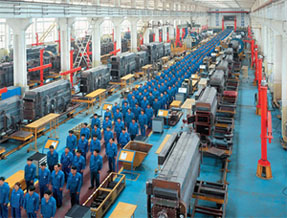Are Privileged GAAP Treatments Keeping China’s SOEs Profitable?
 May 5 – Findings by the research team at the Spanish bank BBVA uncovered specific treatments by the Chinese government used solely for the benefit of its own state-owned enterprises that appear to show a disregard for China’s own generally accepted accounting principles in terms of transparency and fair competition.
May 5 – Findings by the research team at the Spanish bank BBVA uncovered specific treatments by the Chinese government used solely for the benefit of its own state-owned enterprises that appear to show a disregard for China’s own generally accepted accounting principles in terms of transparency and fair competition.
The bank’s Hong Kong unit analyzed the underlying causes for SOE’s posting profits, following Beijing’s announcement that SOE’s profits were up 26 percent in April compared with the same month last year. This follows a study published by the Hong Kong Institute of Monetary Research last week that also concluded that the financial statements and profitability levels of China’s SOE’s were more financial illusion than based on established accounting principles, including GAAP specifications issued by the Chinese Ministry of Finance.
According to the institute, the main issue over increased profitability for China’s SOEs comes through their governmental links to state-owned banks, from which they are able to borrow at very generous rates – an average of 2.55 percent for 2001 through 2005 as compared to private sector companies who paid back loans at 4.53 percent. State-owned enterprises also have the advantage of being able to easily restructure, defer or even write-off loans if they begin to face difficulties in repayment. This behavior has resulted in SOEs being able to demonstrate far higher levels of profitability than would otherwise have been the case. Indeed, the institute went as far as to state that if “state-owned Enterprises had been obliged to pay market interest rates rather than relying on subsidized loans, SOE profits would have been eliminated entirely over recent years.”
China is faced with several difficulties here. Firstly, the main reason that the state continues to fund many SOEs is the absence of a security blanket for workers who would be laid off. Keeping SOEs running, and even falsely profitable, maintains workers in employment and reduces the risk of social unrest. However, in doing so, SOEs are increasingly coming into conflict with China’s own private companies, who are faced with internal competition from other Chinese businesses that are state supported. This causes innovative and dynamic businesses from growing and developing properly at the expense of catatonic SOEs.
Corruption within SOEs is also rife – SOEs are under the lowest level of audit scrutiny from the State Administration of Taxation since the company is government-owned and the assumption is that everything is correct and in-line with regulatory demands.
Finally, the huge stimulus plan China announced recently to assist absorb the fallout from the global economic crisis is largely going to SOEs. This could threaten the well-being both of China’s credit-starved private sector companies, which contribute about 50 percent of China’s annual GDP, but also place China’s state-owned Banks at risk if these loans turn out to be poorly performing in terms of repayment.
Calls for China to level the playing field are on the rise. The government, which continues to pay close attention to social security issues, will need to find a way of transferring staff from inefficient state-owned business to the private sector if this conflict is going to be successfully resolved.
- Previous Article Alibaba Hikes Fees for Global Members
- Next Article China Revises Market Entry Policies for Banks









